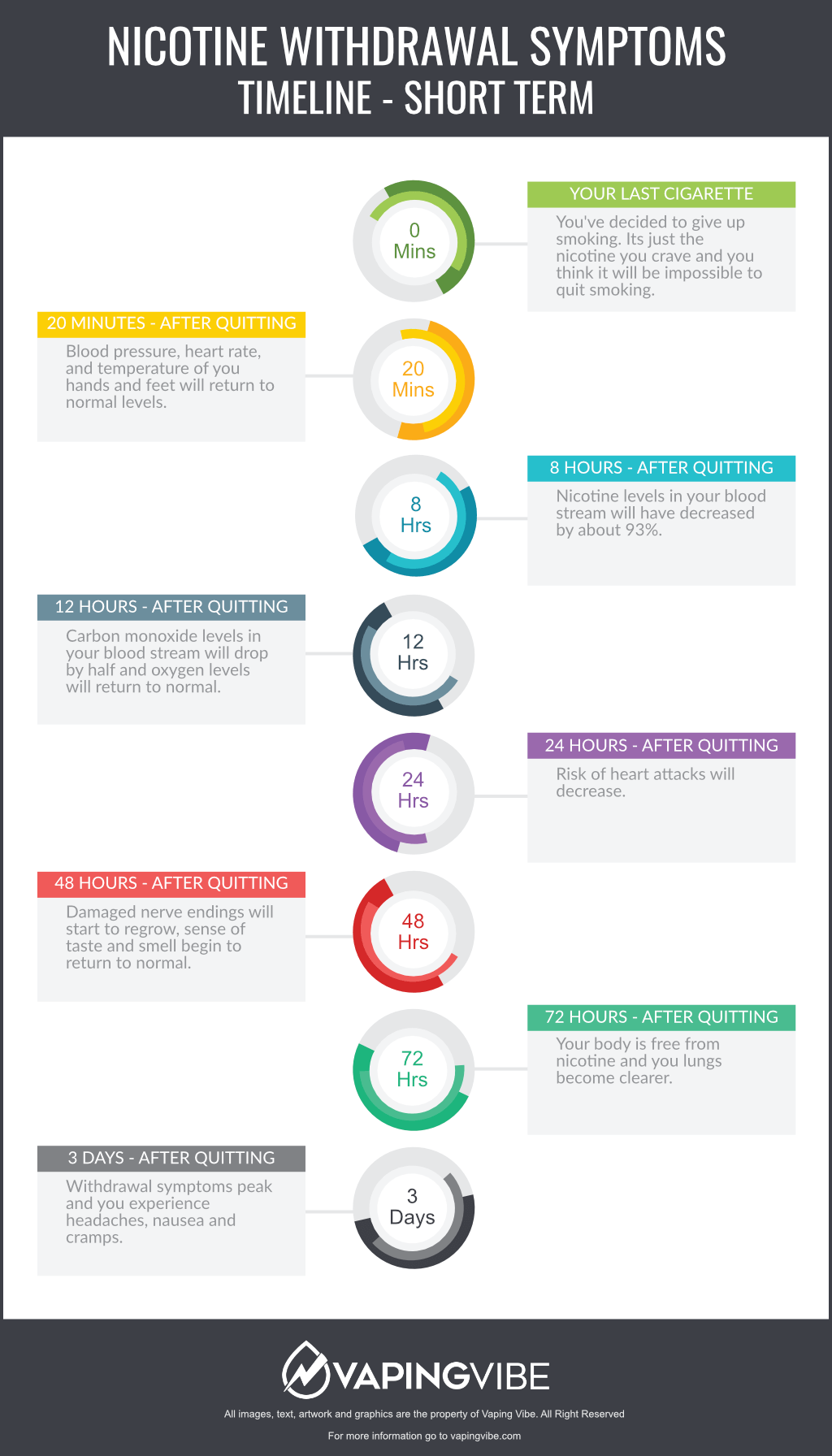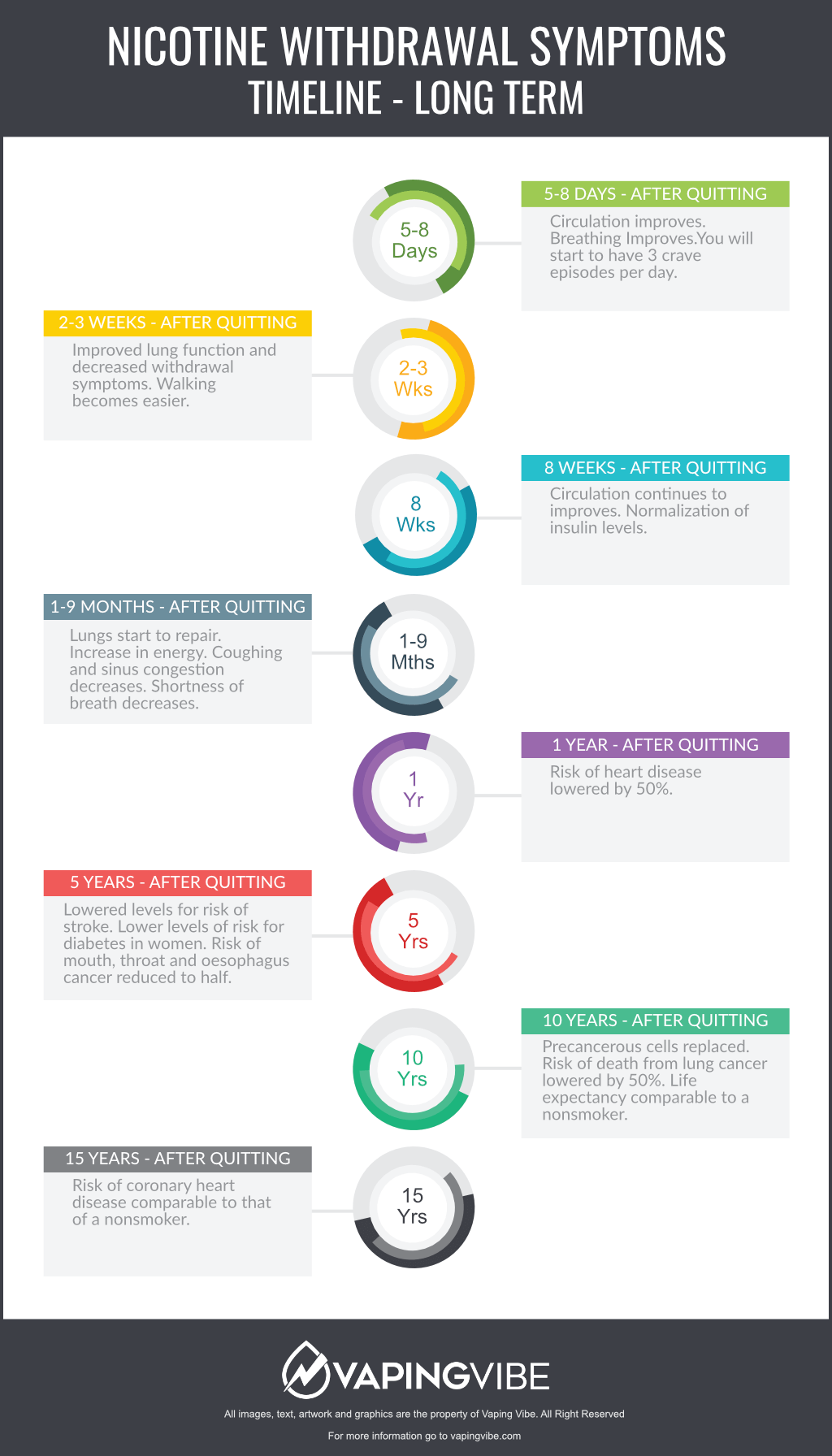SHOW SUMMARY
- Nicotine Withdrawal Timeline & Symptoms – Short Term
- Nicotine Withdrawal Timeline & Symptoms – Long Term
- The Critical Phase: Week One
- Common Withdrawal Side Effects
- The Long Term: Weeks 2-4
- The Rest of Your Life: Week 5 Onwards
- How to Overcome Nicotine Withdrawal
- Strategies for Coping with Nicotine Withdrawal
- Summing up
Are you looking to quit smoking or transition to nicotine free vapes and are worried about the withdrawal symptoms?
Nicotine is the primary substance in cigarettes, other tobacco forms and vaping that make them addictive. Nicotine is a drug that is equally as dangerous as cocaine or heroin with addiction. The side effects of nicotine may be very different from those drugs, but withdrawal is severe, affecting your brain and other body parts.
Over time, a smoker’s body and brain get used to having nicotine as it causes the release of extra serotonin and dopamine in their brain. Roughly 80−90% of people who smoke regularly become addicted to nicotine.
Nicotine can have a wide range of effects on the brain, including boosting mood, reducing depression, reducing irritability, enhancing concentration and short-term memory, producing a sense of well-being and reducing appetite.
“The worst withdrawal symptoms only last a few days to a couple of weeks”
When you stop smoking, your body has to manage not having nicotine which is called withdrawal. Withdrawal can be uncomfortable.
Common symptoms of withdrawal are intense cravings for cigarettes (nicotine), depression, insomnia, weight gain, nausea, headaches, difficulty concentrating, coughing, changes to blood pressure and a sore throat.
For most people, nicotine withdrawal symptoms peak within two to three days and often go away by two weeks. Some people have been known to take longer and experience severe withdrawal symptoms for several months after quitting.
There are plenty of useful tools for quitting nicotine. The most common used to be through nicotine replacement therapy, with the use of nicotine patches or nicotine gum. However more recently vaping has become an excellent way to control nicotine intake. Vapers can control the amount of nicotine within their vape juice, and eventually work their way down to using non nicotine vapes.
However, even while using the above methods to lower nicotine intake, it’s best to be prepared for those moments of desperation by understanding the symptoms, when they are likely to occur timewise and how to manage them to feel better about the process.
The infographic below shows a detailed analysis of nicotine withdrawal symptoms and their timeline to help you understand the nature of nicotine addiction and what it is like to give up the habit.
Nicotine Withdrawal Timeline & Symptoms – Short Term

Nicotine Withdrawal Timeline & Symptoms – Long Term

Long-term or heavy smokers who smoke a large number of cigarettes per day are more likely to experience withdrawal symptoms. Also, symptoms are associated with habits, so certain times of the day, people or places may exaggerate the cravings by association.
As soon as you decide to take that last cigarette, the process of your body getting back to normal will start, the withdrawal will kick in, and you will begin to experience some of the following.
Check out our article for a more in depth view at how long nicotine stays in your system.

The Critical Phase: Week One
The vulnerability of addiction to any particular substance makes it hard to remove it from your life. The symptoms of nicotine withdrawal that are evident in week one are not just confined to the first week and can continue throughout the whole withdrawal process.
Week one is, however, the hardest for smokers to make it through as the body is adjusting after the continuous nicotine exposure. Withdrawal symptoms can start as early as 30 minutes after smoking that last cigarette.
Nicotine has a short half-life, on average around two hours and therefore after two hours, it must be delivered again and in regular doses to maintain the ‘buzz’ the brain needs and has been accustomed to functioning.
“AFTER 8 HOURS NICOTINE LEVELS IN YOUR BLOODSTREAM WILL HAVE DECREASED BY ABOUT 93%”
Breaking the ‘buzz’ to get to the initial critical marker point of eight hours is the first step. If you can get to this point nicotine levels in your bloodstream will have decreased by about 93%.
During these earliest hours, the symptoms of nicotine withdrawal will start with cravings for a cigarette, followed by anxiety, and you will begin to get irritation and anger, and a decrease in mental function causing attention problems and difficulty in completing some tasks. These symptoms will start at 30 minutes after smoking and continue to rise in intensity as time goes on.
Most of the withdrawal symptoms will peak around three days after quitting. You may experience headaches, nausea, and cramps, but the good news is things will begin to taper off after day three as the body starts to clear itself of nicotine.
As the body starts to heal, the physical symptoms during this first week will include a headache, increased appetite, dizziness, constipation, stomach pain, fatigue, and insomnia. The chest will in some cases also tighten, and you will begin to cough or notice an increase in mucus. For smokers, these symptoms are caused by the respiratory system removing the unwanted irritants it was unable to do in the past.
Up to the end of this first week, you are through the short-term effects and days 5-8 will begin to see circulation and breathing will improve. Craving episodes will still occur three times per day.

Common Withdrawal Side Effects
- Irritability and Anxiety – Years of nicotine have caused roller-coaster cycles of rising and falling blood nicotine levels, and these are now ending. Your mind is taking control of neurochemicals that nicotine is affecting, including adrenaline, dopamine, and serotonin. Your brain is resuming control and is sensitive to adjustments with mood, wanting, stimulation and anxiety.
- Lack of concentration – Nicotine feeds the adrenaline in your body. Once the nicotine is removed, it can feel that your concentration is not as good or that your mind now lives in a fog. Poor concentration can also be associated with low blood sugar. Don’t attempt to skip meals, as this will stabilize blood sugar and may also help metabolize nicotine by a small amount.
- Headaches – Many people experience headaches when they are withdrawing from nicotine due to the changes in brain oxygen and chemical levels. Headaches can also be a result of other symptoms such as continued anxiety or tension, possible temporary sleep disruption, increased caffeine levels, or diet changes.
- Fatigue – The body is shedding years of the effects of nicotine dependence, and the withdrawal process can be physically and emotionally exhausting. Your metabolism will also be changing as your heart rate, and respiration is rapidly returning to normal.
- Insomnia – Nicotine affects subconscious thought. It causes disorder of brain waves, deep sleep, and even dreams. Physical withdrawal disturbs ‘normal’ sleep patterns. You may also find you don’t need as much sleep as you did while smoking and may need to establish a new pattern.
- Nausea and Vomiting – Nausea is the uneasy or unsettled feeling in the stomach which can be caused by the worry of cessation, fear, stress, and overeating, which can be exasperated by heartburn, acid reflux, indigestion, gas or bloating.
- Increased Appetite or Hunger – Taste buds and sense of smell will be rapidly healing, and there may be a desire to consume more significant quantities of food. The need for extra calories can also be down to the need for a hand-to-mouth oral crutch or the replacement of adrenaline through increased blood sugar levels.
- Depression and Sadness – Our entire being can be affected by depression and can affect all the other symptoms we’ve discussed. Depression can make you lonely, create sadness, disrupt your sleep, cause poor memory and an inability to concentrate. It can increase fatigue, bring about digestion problems, stomach pains, a loss of appetite or weight gain. It can give you low self-esteem prompting you to neglect your appearance and even loss of sex drive, irritability, hopelessness, and headaches.

The Long Term: Weeks 2-4
The first week produces the majority of withdrawal symptoms. As the symptoms start to fade away over the following weeks, you’ll see an increase in lung function, circulation will continue to improve, and insulin levels will normalize.
Along with these improvements, the withdrawal symptoms will begin to subside:
- Concentration – After 2 weeks mental clarity should begin to improve and there should be less of a foggy feeling.
- Insomnia – Sleeping patterns should start to settle after the end of week one.
- Fatigue – Energy levels will start to increase, but may stay low until 2-4 weeks.
- Nausea – Stomach pain, heartburn, and nausea should start to drop off around 2 weeks and constipation after 4 weeks.
- Hunger – Appetite will start to improve and should return to normal after 2-4 weeks.
- Coughing – Mucus production and coughing will start to clear after 2-3 weeks for some it may persist until 4 weeks.
Nicotine craving is going to be the most significant challenge of the entire withdrawal process and the stresses that come with it. The cravings will cause anxiety and depression and start to show in the typical signs of quitting smoking such as bad moods, short temper, and frustration. These will begin to decrease as cravings become less over the next few weeks and will lessen.
- Background Cravings – This will be the constant desire for a cigarette in the back of your mind. It won’t always be there or be especially overwhelming.
- Intense Cravings – These will be sudden urges that grip you. Intense cravings will be provoked by triggers such as depression, arguments, stress or even rituals such as drinking alcohol, coffee, and even tea.

Intense Craving Causes
- Boredom – Smoking cigarettes takes time and has also become a habit. Without smoking, time needs to be filled, and attention needs to be diverted into new ways. Once you get past the 4-week point, the boredom will reduce.
- Insomnia – The first week will be the worst for insomnia after this milestone it should start to diminish and only happen occasionally. Nicotine is a stimulant, and the brain has been functioning with increased chemicals to improve cognitive function, as they wear off the brain needs to adjust. Fatigue and lack of concentration may continue during weeks 2-4.
- Hunger – Appetite will increase as the nicotine has increased serotonin and dopamine which suppresses appetite. Withdrawal will affect blood sugar levels, and cravings will increase for substitutes such as carbohydrates and sweets. After two weeks this will decrease as the body normalizes but may cause weight gain of 5 pounds or more.
Unfortunately, each person is different, and the nicotine withdrawal timeline is based on the average experience of those quitting smoking. Some people may have fewer symptoms and others may take longer to get through the process. The physical symptoms such as dizziness and headaches are generally short and not severe. The difficulty comes with the emotional, mental, and behavioral withdrawal symptoms; these can continue for an extended period and usually are the obstacle that causes people to lapse.

The Rest of Your Life: Week 5 Onwards
Getting through the first month is the most significant achievement, many of the withdrawal symptoms will have subsided, and you can congratulate yourself on reaching this massive milestone. Cravings will now be reduced, and the emotional and physical symptoms have gone past the peak.
There is still no time to relax, even though physical and mental symptoms of withdrawal have pacified there is always the possibility of relapse which happens to smokers years after having their last cigarette. It’s key to remember the last month after quitting regarding the discomfort you went through to remind yourself of the experience.
Two essential elements could derail your progress and send you back in smoking:
- Mental Cravings – Cravings will still occur especially in the first year, they will be similar to the background cravings and can be increased in certain situations, such as being around tobacco smoke or conditions that remind you of smoking.
- Smoking Nostalgia – There is nothing innately appealing about smoking, and yet you will have sentimental thoughts, remembering good times or the feeling of a cigarette after a meal or first thing in the morning. It was just the addiction being satisfied and not a real sense.
These thoughts will catch you off guard as there is a chance to be nostalgic and lose focus on quitting compared to that of the first month you gave up. Life should have changed and faded into a healthier, happier and smoke-free lifestyle. You just need to deal with any intense cravings, fight the emotions, and mental anguish and continue with the rest of your life.

How to Overcome Nicotine Withdrawal
- The right mindset: Making up your mind to quit smoking determines success rate. Make a list of reasons you want to stop and keep the list close-to-hand to help encourage you why you are quitting and give you motivation.
- Cravings pass quickly: Nicotine cravings only last about six minutes. That’s roughly the length of a few songs. Make yourself a playlist to distract yourself during that time. You don’t even have enough time to go to the store and buy a new pack. Just remember when the urge strikes it will be over quickly.
- Take comfort in numbers: There are now more ex-smokers than there are smokers. Seventy percent of smokers want to quit. Each year about 1.3 million smokers quit smoking. A pack a day will cost you about $1,500 a year. When it starts to get tough, just remind yourself of the millions of people who have made it through the quitting experience.
- Change your routine: Smoking is partly a habit and can be somewhat predictable, you probably smoke at the same times every day. Waking up, driving to work, a cup of coffee or after a meal and many other times can all be events when you associate smoking. Consider alternative routines, driving a different route to work, mixing up your morning schedule or chewing gum after eating.
- Create healthy habits: Moderate physical activity will also help to reduce nicotine cravings. Withdrawal symptoms and cravings for cigarettes decrease during exercise and for as long as 50 minutes afterward. Combine this with healthier snacks, to limit weight gain, improve your mood and help you cope with stress and feel more energetic.
- Get extra sleep: Withdrawal symptoms from quitting smoking include difficulty sleeping and tiredness. Feeling exhausted is a typical, transient symptom when you stop smoking. Nicotine is a stimulant that kept your body alert and in the past made you feel like you needed to get less sleep. If you feel tired, take a nap, this will also help your body heal from the discomfort of nicotine withdrawal.
“Cravings last the length of a few songs! Make a playlist to distract yourself”

Strategies for Coping with Nicotine Withdrawal
- Surround yourself with support: Going through a difficult time is always easier when you can turn to friends and loved ones for emotional support. Make sure you let them know in advance that you will need the assistance of listening ear or a distraction when quitting smoking is at its toughest. Ask for their patience knowing you may get a little grumpy. They love you and will want you to get through this time as you’ll be much healthier once you successfully quit smoking.
- Reward yourself daily: Each day you complete smoke-free is an achievement and quitting is not the only reward. To prevent the urge to smoke, treat yourself for the first month at least once a day. They don’t always have to come at a cost and could be something simple like time alone to relax with a good book or a hot bath. Simply something toward helping you feel good about the work you’re putting into smoking cessation. If you can choose rewards that also help you release tension, all the better.
- Keep your hands busy: Holding a cigarette is a familiar feeling for smokers, find alternative objects to keep your hand occupied. Use an e-cigarette, keep a pen or small pencil in your pocket, carry some gum or candy or even a game on your phone to play. These can all be good distractions and replacements for that nervous habit.
- Change your life, change your mind: The average person has approximately 60,000 thoughts a day. Much of what you think is negative, and you will tell yourself that quitting smoking is going to be uncomfortable and hard, and that will make it a more challenging experience. Your mind believes what you tell it, so rather than thinking “I’ll never stop missing cigarettes.” start to think “I know that I’m missing cigarettes right now because I’m addicted to nicotine. Once I recover from that, I won’t miss smoking anymore.” If you believe that you can do it, and you will!
- Use momentum as a Tool: When you start to quit smoking the first few weeks will be difficult. Once you get past these difficulties, everyday smoke-free will make you stronger and more able to succeed. Each day you are building momentum that will propel you forward with greater ease as the time goes by.
- Smoking cessation is not a race: When you quit smoking, you want all the discomforts associated with nicotine addiction to be over with quickly. That’s understandable but unrealistic. Recovery takes time, so you need to relax and use the time to your advantage. If you start to exercise or find a hobby to keep you occupied the time will go quicker. How long it takes to put smoking behind you is how long it takes. Trust the process, and you will heal fully, like so many who quit smoking.
“I KNOW THAT I’M MISSING CIGARETTES RIGHT NOW BECAUSE I’M ADDICTED TO NICOTINE. ONCE I RECOVER FROM THAT, I WON’T MISS SMOKING ANYMORE”
Summing up
Nicotine is an addictive substance, and with any form of addiction it’s best to understand the side effects and symptoms you may face when removing that substance from your body. Hopefully through this article we have given you an understanding of the common nicotine withdrawal symptoms. Along with the expected timeline that most people face when quitting nicotine.
Nicotine cravings can be difficult to cope with, but stick with it and remember why you wanted to quit in the first place. The health benefits will far outweigh any difficult period you face, which will gradually lessen with time.
If you’re still not quite ready to kick the nicotine habit, it might be comforting to know there are some surprising benefits to nicotine.

